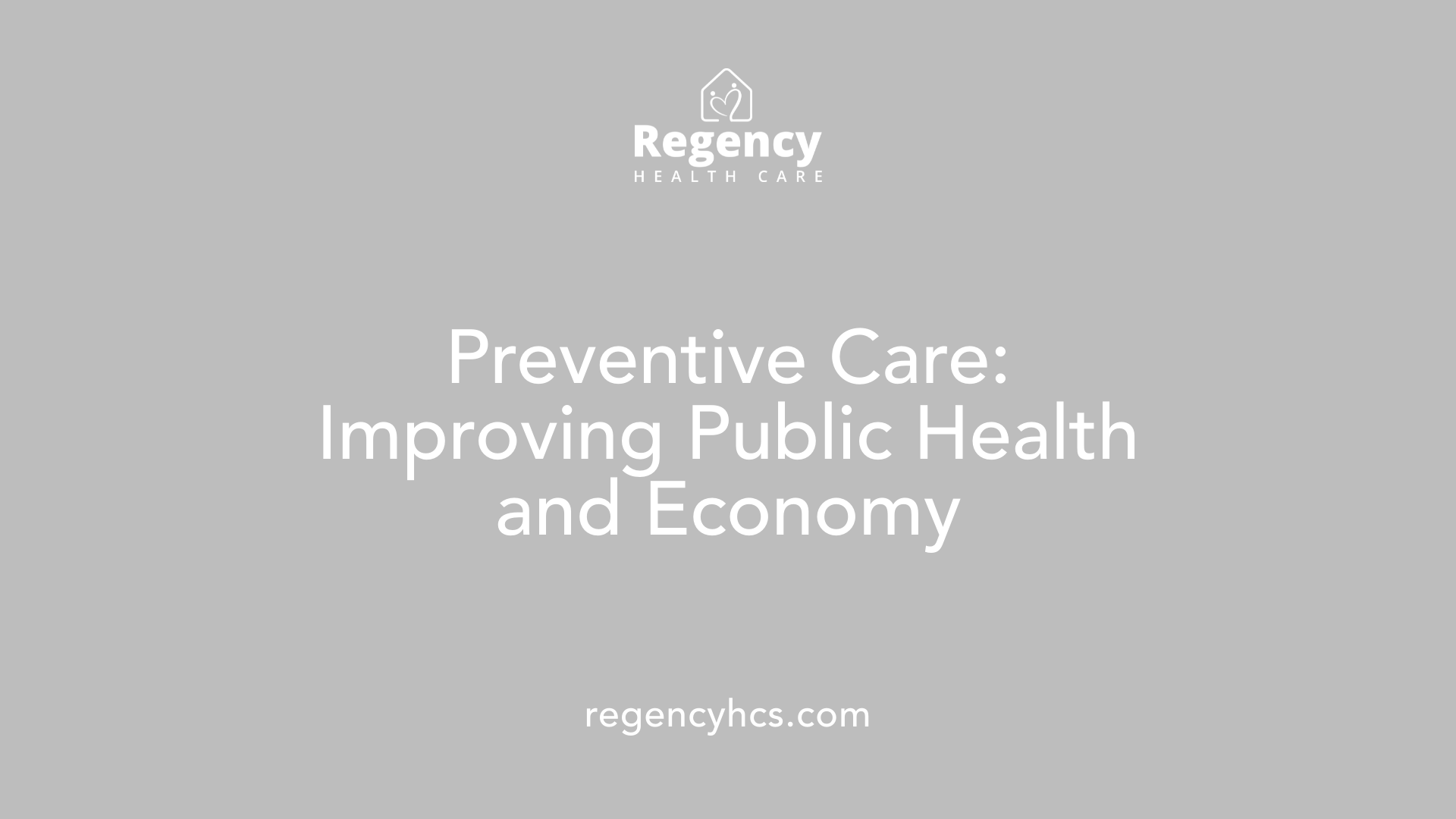Understanding the Power of Prevention in Home Care Settings
In the evolving landscape of healthcare, preventive health practices have emerged as a cornerstone of delivering effective, safe, and patient-centered care at home. By focusing on early detection, disease prevention, and maintaining overall well-being, these practices play a vital role in reducing hospitalizations, lowering costs, and improving quality of life, especially for seniors and individuals managing chronic conditions.
The Role of Preventive Care in Health Optimization at Home

Why is proactive health management important for individuals living at home?
Proactive health management is essential for those living independently because it helps identify potential health issues early on, preventing serious complications and maintaining a good quality of life. By engaging in regular activities like health checkups, vaccinations, and screenings, individuals can stay ahead of chronic diseases such as hypertension or diabetes.
Additionally, proactive strategies involve maintaining medication adherence, participating in physical activity, eating healthily, and fostering strong social connections. These steps promote physical and mental well-being, which are vital for sustaining independence. Multi-disciplinary teams, including nurses, doctors, and therapists, play a key role in personalized care planning and timely interventions to support complex needs.
Engaging in mindfulness practices, planning healthcare directives, and ensuring safety through home modifications also contribute to mental health and security. Overall, being active in health management helps delay health deterioration, lowers the risk of emergency hospital visits, and improves overall life satisfaction for those at home.
Implementing Preventive Measures in Home Settings

What are some strategies for implementing preventive health measures in home care?
Applying preventive health strategies in home care involves multiple tailored approaches to ensure safety and early detection of health issues. Regular health screenings and vaccinations are fundamental; they help identify early signs of disease such as hypertension, high cholesterol, or early-stage cancers, enabling prompt intervention.
Risk assessments and environmental modifications play a crucial role. Simple changes like installing grab bars, improving lighting, and removing tripping hazards can significantly reduce fall risks. These measures protect vulnerable populations, especially seniors, from injuries.
Training family members and informal caregivers enhances care quality. Caregivers should learn about proper medication management, infection control, and safety practices. This education minimizes errors and promotes better health outcomes.
Technology also offers powerful tools for prevention. Telehealth consultations, remote sensors, and remote patient monitoring devices help track vital signs continuously. Early warning signs of deterioration can be flagged, allowing for quick responses that may prevent hospitalization.
Comprehensive care planning should incorporate social support considerations, addressing barriers like transportation and access issues. Emphasizing infection prevention with hygiene practices and protective equipment is vital, especially for immunocompromised patients.
By integrating these strategies—regular screenings, environmental safety, caregiver training, and advanced technology—home care providers can effectively reduce health risks, improve safety, and maintain independence for individuals receiving care at home.
Impact of Preventive Care on Population Health and Costs
 Preventive care plays a crucial role in improving public health and reducing overall healthcare expenses. By focusing on early detection and intervention, it helps identify health issues such as hypertension, high cholesterol, and early-stage cancers before symptoms develop. This proactive approach not only enhances individual well-being but also translates into substantial cost savings for the healthcare system.
Preventive care plays a crucial role in improving public health and reducing overall healthcare expenses. By focusing on early detection and intervention, it helps identify health issues such as hypertension, high cholesterol, and early-stage cancers before symptoms develop. This proactive approach not only enhances individual well-being but also translates into substantial cost savings for the healthcare system.
When health problems are caught early, treatments tend to be less invasive, less costly, and more effective. Routine screenings, vaccinations, and health education encourage healthier behaviors, which decrease the likelihood of developing chronic conditions like diabetes and heart disease. Furthermore, preventive strategies such as lifestyle counseling and personalized risk assessments promote long-term health maintenance.
Reducing hospitalizations and complications is another significant benefit of preventive care. Fewer emergency visits and hospital stays occur because health issues are managed proactively. For example, effective diabetes and hypertension management help prevent costly complications such as kidney failure or strokes.
Research indicates that although initial expenses for preventive services may increase due to screenings and immunizations, these costs are offset by long-term savings. This is achieved through decreased reliance on urgent care, fewer hospital admissions, and reduced need for expensive treatments for advanced diseases.
In summary, investing in preventive health measures results in healthier populations and more sustainable healthcare spending. It emphasizes a shift from reactive to proactive care, ultimately fostering better health outcomes, longer lives, and economic benefits for society.
The Significance of Preventive Health in Reducing Morbidity and Mortality

What is the significance of preventive health care?
Preventive health care is essential because it allows for early detection and management of health issues before they escalate into more severe conditions. This approach emphasizes regular checkups, screenings, vaccinations, and lifestyle adjustments that can significantly decrease the risk of chronic illnesses such as heart disease, cancer, and diabetes.
By focusing on prevention, individuals benefit from improved health outcomes and a better quality of life. Early diagnosis through routine screenings for high blood pressure, cholesterol, and cancer enables timely treatment, often resulting in less invasive and more effective interventions.
Vaccinations play a pivotal role in protecting individuals and communities from infectious diseases like influenza, pneumonia, and shingles. These preventive measures reduce the incidence of illness and complications, especially among vulnerable populations such as seniors and immunocompromised individuals.
Addressing health disparities and promoting equity are also vital aspects of preventive health. It involves ensuring all populations have access to essential services—including screenings, vaccinations, and health education—regardless of socioeconomic status. Barriers like cost, transportation, and lack of awareness must be tackled to make preventive services accessible for everyone.
Strategies such as community outreach, policy change, and interprofessional team approaches help overcome these barriers. For example, collaborative care models involving diverse healthcare professionals improve the reach and effectiveness of preventive measures.
Overall, preventive health isn’t merely about avoiding disease; it fosters a health-conscious culture that supports longevity, well-being, and equitable health outcomes. Investing in prevention through education, accessible services, and coordinated care aligns with future healthcare goals of reducing illness burden and promoting healthier communities.
| Focus Areas | Key Actions | Benefits |
|---|---|---|
| Early detection & management | Routine screenings, health checkups | Reduced morbidity, early treatment |
| Vaccinations & screening programs | Immunizations, cancer screenings | Prevention of infectious, chronic diseases |
| Promoting health equity | Access for underserved, inclusive policies | Improved outcomes, reduced disparities |
By integrating these elements, preventive health care significantly contributes to lowering mortality rates and enhancing overall public health. Expanding coverage and awareness remains crucial to maximizing these benefits.
Enhancing Patient Safety and Quality of Life through Prevention
 Preventive health measures are fundamental in safeguarding patient safety and elevating quality of life. They serve as proactive defenses, reducing the likelihood of developing diseases, disabling conditions, and preventable harms. Regular screenings, vaccinations, and health check-ups help identify potential health issues early, often before symptoms appear, allowing for timely intervention. This early detection can lead to more effective treatments and prevent complications that might otherwise result in hospitalizations or long-term health problems.
Preventive health measures are fundamental in safeguarding patient safety and elevating quality of life. They serve as proactive defenses, reducing the likelihood of developing diseases, disabling conditions, and preventable harms. Regular screenings, vaccinations, and health check-ups help identify potential health issues early, often before symptoms appear, allowing for timely intervention. This early detection can lead to more effective treatments and prevent complications that might otherwise result in hospitalizations or long-term health problems.
Preventive care also plays a vital role in managing chronic illnesses such as hypertension, diabetes, and heart disease. By controlling these conditions early, patients are less likely to experience severe health events or require emergency treatments. Additionally, vaccination programs protect against infectious diseases, significantly decreasing illness severity and mortality, especially in vulnerable groups like the elderly.
Addressing barriers—such as high costs, limited access to primary care, and lack of awareness—is essential for increasing the utilization of preventive services. Improving education and policy support can expand access, ensuring more individuals benefit from early health interventions.
Overall, emphasizing preventive health fosters safer care environments, enhances health outcomes, and supports healthier aging. It helps individuals maintain independence, reduce healthcare costs, and enjoy a better quality of life. Prioritizing prevention aligns with comprehensive healthcare goals, ultimately promoting a safer, healthier society.
Moving Towards a Culture of Prevention in Home Care
The integration of preventive health practices into home care not only bolsters individual health outcomes but also contributes significantly to the sustainability of healthcare systems. By emphasizing early detection, managing risk factors, and fostering health-promoting behaviors, home-based preventive care sets the stage for healthier aging, reduced hospital admissions, and lower healthcare costs. Overcoming barriers such as lack of awareness and access is essential to maximize the reach of these benefits. As healthcare continues to shift from reactive treatments to proactive prevention, embracing comprehensive, patient-centered strategies will ensure better health, safety, and quality of life for individuals living at home.
References
- Preventive Care - Healthy People 2030 | odphp.health.gov
- Patient Safety and Quality in Home Health Care - NCBI
- The Importance of Preventative Care for Seniors at Home
- The Importance of Infection Control in Home Health
- Why Preventive Healthcare Matters In Senior Care Communities
- Enhancing primary care and preventive services through ...
- What is Preventive Healthcare? Why It's Essential for Your Well-Being

How NHTD Supports Individuals with Traumatic Brain Injuries
April 25, 2025
Supporting Brain Injury Recovery and Community Integration

How TBI Services Help Address Cognitive and Emotional Challenges
April 25, 2025
Comprehensive Strategies for Recovery and Support in TBI Care

How to Find Community-Based Services Through the NHTD Program
April 25, 2025
Unlocking Community Supports for Independent Living

How to Manage Pain Effectively with Home Care Services
April 25, 2025
Transforming Pain Care: A Guide to In-Home Strategies

The Importance of Open Communication Between Families and Care Teams
April 24, 2025
Bridging Gaps for Better Care

The Role of Service Coordinators in the NHTD Waiver Program
April 24, 2025
Empowering Independence: How Service Coordinators Drive Success in the NHTD Waiver Program



